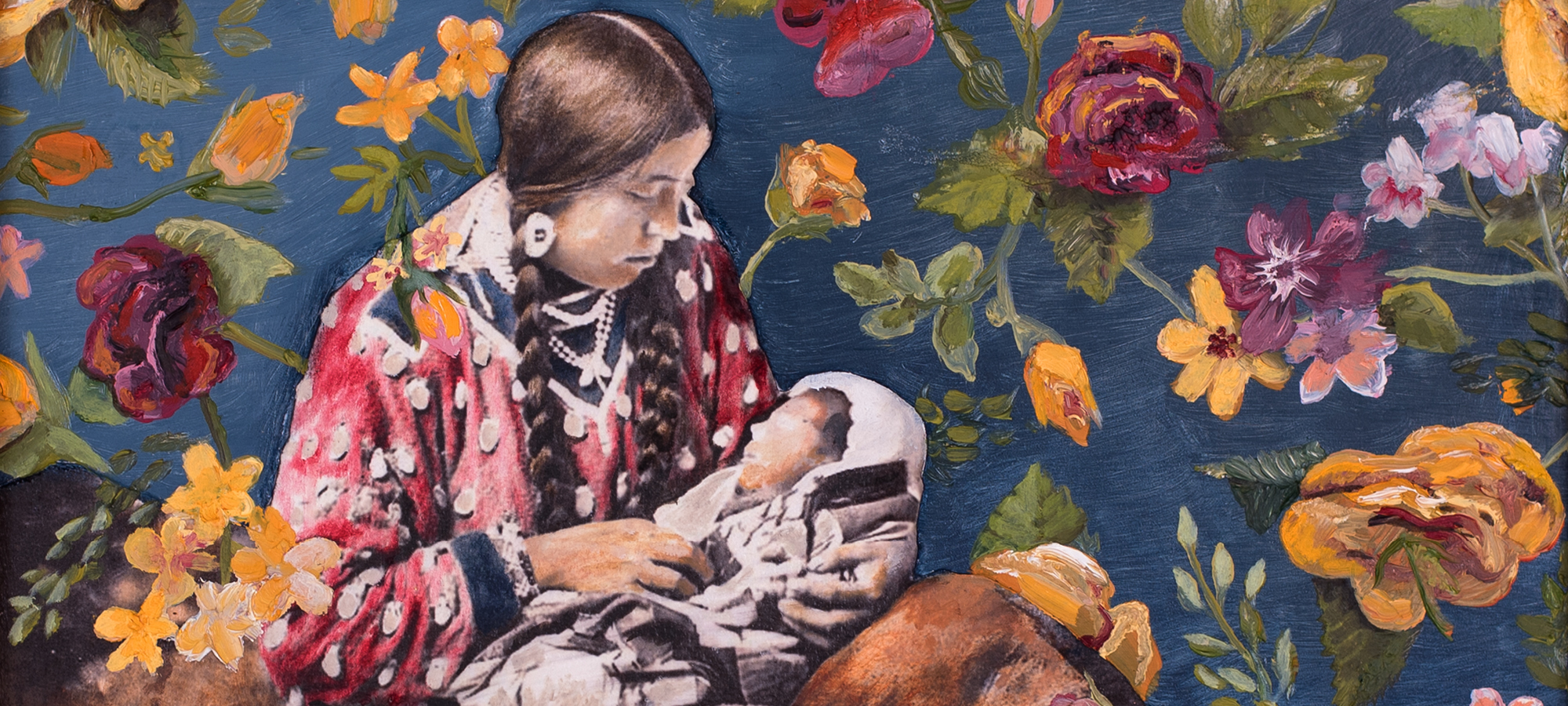
This painting by Ben Pease depicts an Apsáalooke woman in a traditional dress covered wih elk teeth, holding her baby. It’s one of many works by contemporary Native artists that will be featured at the Field Museum and the Neubauer Collegium. (© Ben Pease - Wherein Lies the Beauty of Life)
Apsáalooke Women and Warriors goes beyond natural history
Apsáalooke warriors began their training as children. To prepare for the acts of bravery they would one day need to perform in battle, the boys of the tribe, pronounced “Ahp-SAH-luh-guh” (also known as Crow), practiced what they called “counting coup” on game animals. Counting coup involved touching an enemy but not otherwise harming him; to achieve the feat, according to the great chief Plenty Coups (1848–1932), “a warrior would often display great bravery.”
The tradition of “counting coup” is one of many aspects of Crow life that will be highlighted this spring in Apsáalooke Women and Warriors, an exhibition at the Field Museum of Natural History and the gallery at the Neubauer Collegium for Culture and Society. Both sites will spotlight Crow artifacts, including a tipi at the Collegium and 21 never-before-displayed war shields at the Field. Juxtaposed with the artifacts will be beadwork, paintings, photography, fashion, and other works by contemporary Crow artists.
The goal of the exhibition, guest curated by Apsáalooke artist and scholar Nina Sanders, is simple: to show visitors that Native Americans have a present and a future, not just a past. As Sanders told WTTW, “This is a celebration of our culture and our resilience and how the things we were making in the very beginning are still the things we are making today.” It’s also the first time the Field—and perhaps any natural history museum—has hosted an exhibition of Native artifacts curated by a member of the featured tribe.
For philosopher Jonathan Lear, the Roman Family Director of the Collegium, Apsáalooke Women and Warriors continues an interest in the Crow that began at a lecture just over 30 years ago. The speaker quoted Plenty Coups’s stark summary of life after the tribe’s 1868 confinement to a reservation: “After this, nothing happened.” Years later, the quote clicked into Lear’s brain like a record in an old jukebox.
He read Plenty Coups’s biography and was struck by the courage the chief had displayed in telling his story to a white writer named Frank B. Linderman. After all the injustices he and his tribe had suffered, Plenty Coups had no reason to trust Linderman, yet he found peace in sharing his story. “You have felt my heart, and I have felt yours,” Plenty Coups told Linderman. Lear’s interest in Plenty Coups and the Apsáalooke resulted in Radical Hope: Ethics in the Face of Cultural Devastation (Harvard University Press, 2006), about the tribe’s endurance after the destruction of its nomadic way of life.
To continue the conversation the great chief had initiated, Lear joined forces with Alaka Wali, the curator of the North American Anthropology collection at the Field Museum. Wali had worked with the Neubauer Collegium before—in 2015, she participated in Open Fields, a collaborative research project focused on the representation of Native American art and artifacts in US museums. That project brought together scholars, artists, and indigenous leaders; their conversations helped lay the groundwork for Apsáalooke Women and Warriors. (Wali and Sanders are also current Neubauer Collegium visiting fellows.)
Rethinking how Native cultures are presented at the Field had long been a goal of Wali’s. The collection began with artifacts displayed at the World’s Columbian Exposition, at a time when anthropologists and archaeologists believed they were salvaging the remains of dying civilizations—not realizing that by separating tribes from their material history, they were harming the very cultures they sought to preserve, and losing crucial context.
Wali’s efforts to bring Native perspectives into the Field’s work have included partnering with contemporary artists to develop exciting and respectful ways of repurposing the museum’s collection. In 2013 she invited Pawnee artist Bunky Echo-Hawk to create an exhibition that paired his paintings with the museum’s Pawnee artifacts; in 2018 Kanza artist Chris Pappan’s drawings were displayed as transparent overlays on glass cases of Native artifacts. The museum has also begun a large-scale renovation of its Native North American Hall, to be completed by 2021.
With Sanders, Lear and Wali originally envisioned creating another small exhibition that would pair contemporary art with the Field Museum’s collection of sacred Crow shields—but Wali’s colleagues were so excited by the idea that they proposed having Sanders curate a major exhibition in one of the museum’s ticketed galleries.
Like the Field’s show, the Neubauer Collegium’s exhibition aims to deepen viewers’ understanding of the Crow’s origins, cultural worldviews, and egalitarian gender roles—but at a more intimate scale and taking a more conceptual approach. Visitors “will literally step inside a Crow tipi that serves as a womb of sorts,” says Dieter Roelstraete, the Neubauer Collegium’s curator. “They will get a chance to immerse themselves in the exhibit and gain an even better understanding of the themes the Field Museum is focusing on.”
Placing historical artifacts alongside pieces that show contemporary Crow culture “transforms the meanings of the artifacts themselves,” Lear says. “They will no longer be viewed as remnants of ‘natural history.’ Because of this show, they will be seen as evidence of a living cultural vibrancy among the Crow people.”
For her part, Sanders hopes the exhibition will inspire other museums to “open space for indigenous people” to participate in the sharing of their culture. “What is being seen as revolutionary is really just common sense.”
